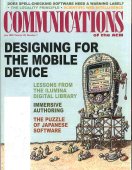July 2005 - Vol. 48 No. 7

Features
Reflections on a Programming Olympiad
Top 10 Downloads from ACM’s Digital Library
The Puzzle of Japanese Software
Instant Messaging and the Future of Language
Contextual and Cultural Challenges For User Mobility Research
Mobile Research Strategies For a Global Market
A Carrier’s Perspective on Creating a Mobile Multimedia Service
Applying -ser-Centered Design to Mobile Application Development
For Mobile Applications, Branding Is Experience
Metadata Lessons from the Ilumina Digital Library
Immersive Authoring: What You eXperience Is What You Get (WYXIWYG)
Does Spell-Checking Software Need a Warning Label?
A Closer Look at Attention to Detail
Scientific Web Intelligence: Finding Relationships in University Webs
The Internet-Based Education Bandwagon: Look Before You Leap
-Understanding the Interactivity Between Television and Mobile Commerce



